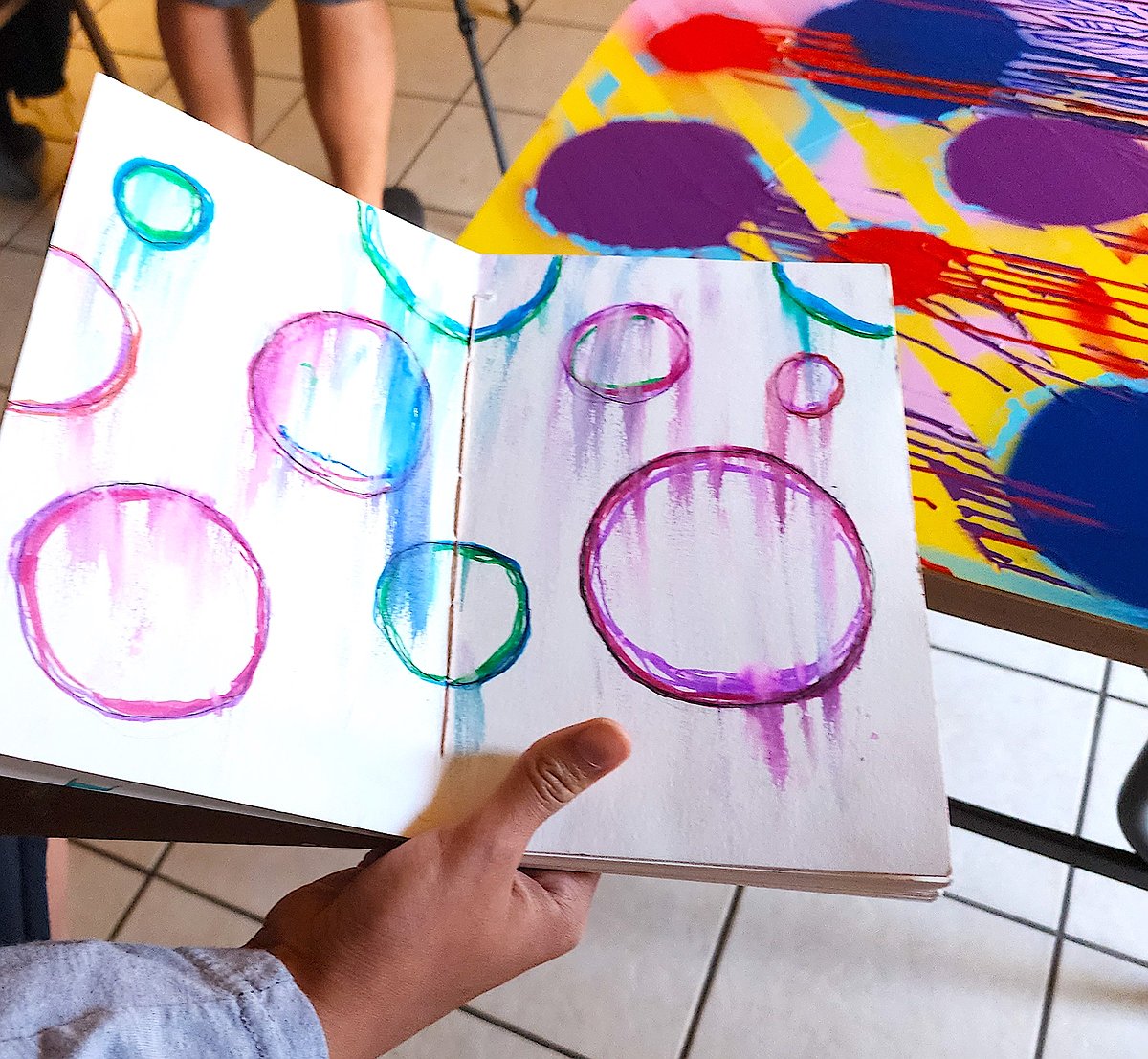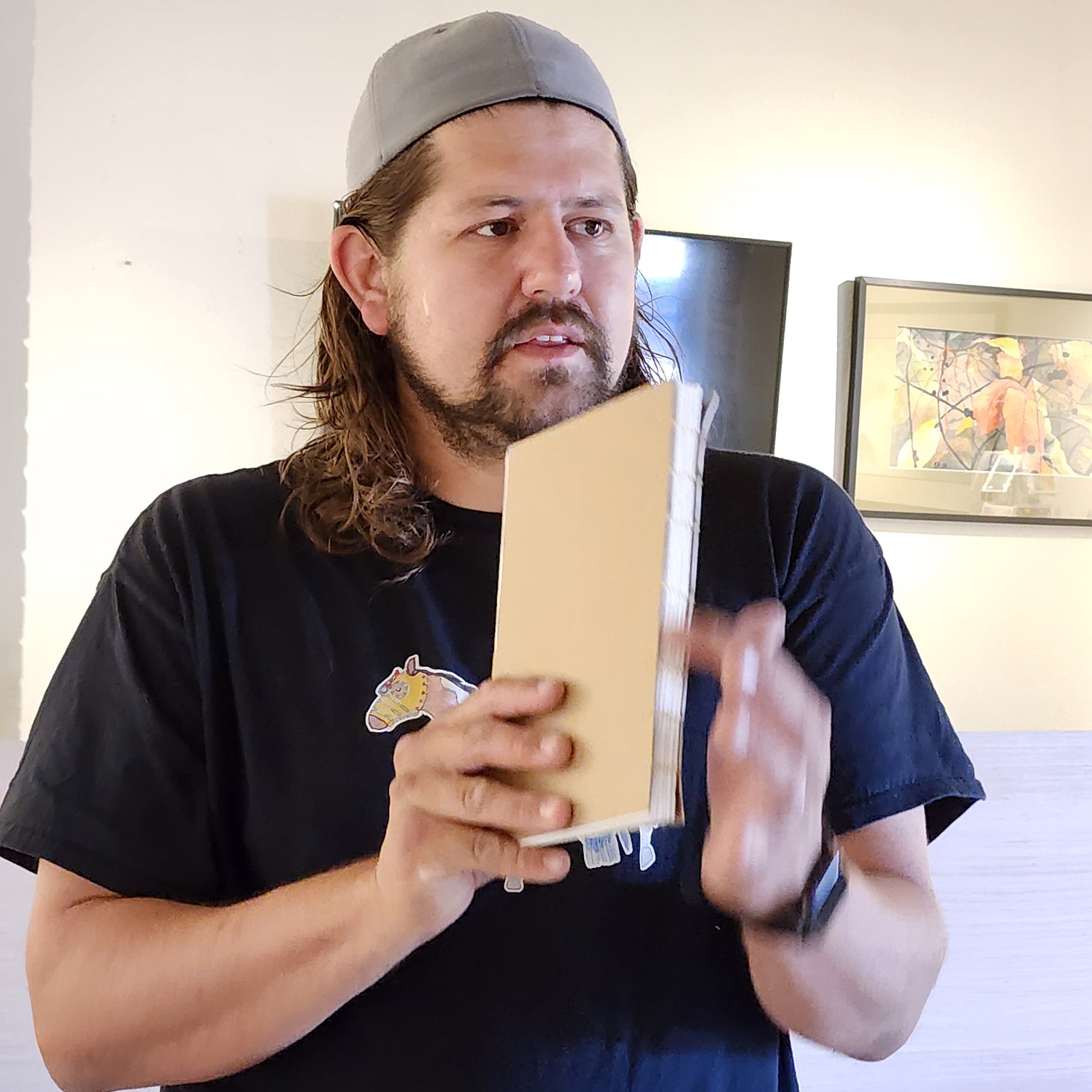Students in Teen Art Project to unveil work June 20
“It’s floral design,” Deja-nay Little-Mary said, showing a page of her Coptic art book, which had sketches, ideas and other art projects from the two-month Teen Art Project (TAP) class, held on Fridays at the Community Development Center in Arlee.
In a previous session, instructor Cameron Decker had shown the teens how to construct and stitch the Coptic book, based on a design used by early Christians in Egypt from the second century A.D. to the 11th century. The beauty and functionality of the book is that each page lays flat.
Last Friday, Decker used a projector to enlarge Deja-nay’s design onto her eight-foot board, so she could transfer the outline from book to board.
To complete her board, she’ll use spray paint. All the boards will become community art pieces around Arlee, with a community unveiling on June 20.
Originally Decker’s idea had been to use the plastic coating on the many billboards found near Arlee and dotting the Mission Valley. But paint doesn’t adhere to the plastic so Decker pivoted and changed material.
The digital projector was also helpful. “I used to pressure myself to freehand everything,” Decker said, even a huge piece such as the ones students are creating, until he met a Denver-based muralist who was working on an enormous buffalo painting.
Decker was a fine arts faculty member at Salish Kootenai College at the time, and the artist took a projector out of his bag and showed Decker how he used it in his work.
Other inspirations include artists in the 1800s, who used a camera obscura, which deploys just a pinhole of light to project an image from the natural world on the opposite surface. Even Michelangelo and Da Vinci are said to have dabbled in this technique.
During an art residency in Missoula, Decker and his wife, Aspen, were allowed to use the Maker’s Space in the Missoula Public Library.
“I got to use technology I never thought I’d be able to access. It really opened my mind to technology – 3D printers and scanners, laser engravers, etc., ways to use technology to make art,” Decker said.
Utilizing this technology, Decker’s TAP class created small creatures and scanned them. A 3-D printer was used to produce three-dimensional creatures, smaller than the originals, which were presented to students during a field trip to Missoula.
The teenagers also visited other outdoor artwork, including the murals and signage that adorn some Missoula alleyways. Back home in Arlee, art created by the TAP class may go up in alleys or on buildings.
Naomi Fisher had drawn a horse and a teddy bear and was debating which one to choose for Decker to project on her board.
Justine Shelby had spray-painted her piece of paneling and was working on details with coloring, layering and overlapping designs. A drawing in her art book showed the beginnings of her design, circles of various sizes and colors shaded and dripping color.
Outdoors, Christine Woodcock and Decker stapled a dropcloth to a wooden stand, providing an “easel” to prop her board against to begin painting.
“Get a base layer down,” advised Decker, adding that the young artist would need two layers of paint.
Decker and his wife have worked with a lot of third, fourth and fifth graders in the Mission Valley. But these students were his first teenagers.
“We can have higher level art conversations,” he said.
The spray paint used is “professional graffiti paint.”
The TAP class is sponsored by the Missoula Art Museum with funding from the National Endowment for the Arts and the Bill and Rosemary Gallagher Foundation. Those resources help fund a professional artist as an instructor and quality art supplies.
It’s a testament to Decker that the kids were still attending on the day after school let out for the summer, and arrived at 9 a.m. Another draw was Stageline pizza for lunch.
As Decker moved back to the indoor classroom, he asked the kids to use as much of their board as they could, then told them about a “huge bull trout that I made out of two of these sheets of paneling.”
He made the piece in his yard, the front half first, and then he drew the tail and put the fish together.
Arts programs for kids “aren’t very strong” in the Mission Valley, he said, noting that access can be complicated by lack of transportation, age, or even supplies. Decker would like to see more art classes and workshops and displays of community art.
About the artist
Decker is a professional artist who earned his undergraduate degree from the University of New Mexico. He was initially interested in art history. Then he started with ceramics, which “got me into studio work,” and began making Japanese-style work.
He earned his Master of Fine Arts in Integrated Arts through the Creative Pulse Program at the University of Montana and is now a painter, printmaker and ceramic artist. He takes pride in educating people about art and bringing people together for meaningful art experiences.
Aspen, Decker’s wife, is a member of the Confederated Salish and Kootenai tribes and is one of the few fluent speakers remaining; she’s teaching Cameron to speak Salish. Together they are raising their four young children to be creative, cultural and fluent Salish speakers.
Aspen and Cameron own Xʷixʷilt, which translates to “alive and well’ in Salish. Together, they focus on ways to support Montana schools and institutions with authentic, appropriate and engaging lessons about indigenous values, contributions, and innovations.





